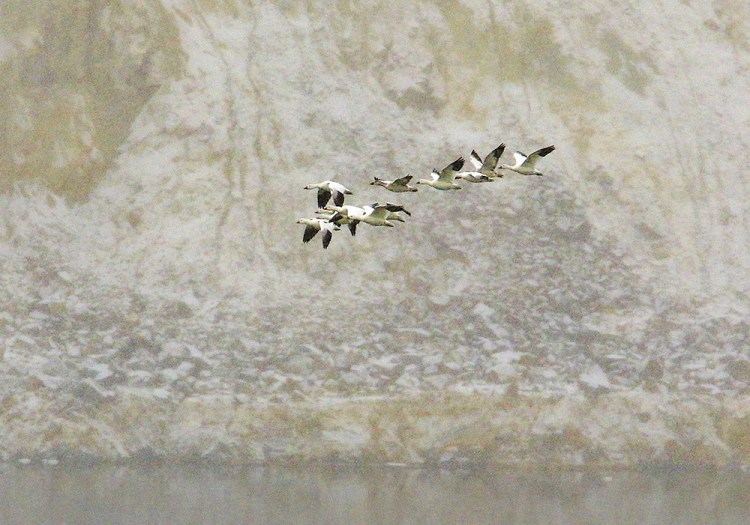Snow geese migrate in huge, honking flocks, each bird winter-white except for a beak and wingtips smudged black. A single flock may comprise tens of thousands of birds. When the geese land en masse, bird hunters call it swirl, as though a twister were touching down rather than 4-pound animals.
On Nov. 28, a great flock of snow geese traveling south came upon small body of water in Butte, Mont. They swirled.
This was no ordinary pond, however. It was the 700-acre Berkeley Pit, a former mine now submerged in water as acidic as distilled vinegar. From 1955 until operations ceased in 1982, miners extracted nearly 300 million tons of copper ore from the pit. They left behind an immense crevasse, which filled with water 900 feet deep. Concentrated within the floodwater are arsenic, cadmium, cobalt, copper, iron, zinc and other inorganic compounds.
After it was abandoned, the pit became a federally managed Superfund site. It also became a tourist destination, where visitors observe the mine’s toxic, reddish water for an admission fee of $2. And microorganisms able to survive in the pit became an object of scientific study.
But snow geese, unlike extremophilic green slime, cannot tolerate acid water heavy in metallic compounds. Roughly 10,000 geese landed in the Berkeley Pit at the end of November, turning the water “white with birds,” said a mine official with Montana Resources, which jointly manages the pit with the Atlantic Richfield Company, to the Montana Standard. On Tuesday, investigators could not give an exact measure of how high the death toll would go. But a preliminary estimate, via drone and flyover counts, found thousands of dead birds.
“I can’t underscore enough how many birds were in the Butte area that night,” Mark Thompson, a Montana Resources environmental affairs manager, said to the Associated Press. “Numbers beyond anything we’ve ever experienced in our 21 years of monitoring by several orders of magnitude.”
As it happened this November, it has happened before.
Twenty-one years ago, in November 1995, 342 snow goose carcasses were found floating in the mine pit. High Country News reported at the time that the Atlantic Richfield Company initially disputed the water was to blame. The company pointed to a Colorado State University necropsy of two birds, which suggested the animals had died from eating tainted grain.
The grain defense did not stick. “Postmortems conducted under the auspices of the University of Wyoming later revealed what most people immediately suspected: that the geese had succumbed to the water, which is acidic enough to liquefy a motorboat’s steel propeller, and to its poisonous mineral contents, principally copper, cadmium, and arsenic,” wrote Harper’s in 1996. “In each bird autopsied, the oral cavity, trachea, and esophagus, as well as digestive organs like the gizzard and intestines, were lined with burns and festering sores.”
Because exposure to the pit water does not mean instantaneous death, officials will refine the 2016 toll in coming days. In the week since the birds landed, Butte residents have found dead birds in a Wal-Mart parking lot, on roadsides and outside the city, the Montana Standard reported.
“Trying to get some idea of mortality has been difficult,” said Joe Vranka, the EPA’s Montana Superfund director, to the Billings Gazette.
Due to the dangers that the mine posed to birds, the companies managing the pit had enacted a hazing strategy to scare animals from spending too much time on the water. This included an observation deck, with scopes and spotlights. If spotters saw an incoming flock, employees would fire off shotguns or loud rifles to deter the animals from coming closer. Around the pit are devices called Phoenix Wailers, speakers which emit predator cries and loud electronic noises. Until November, the effort seemed to be working; the EPA recorded 14 bird fatalities at the Berkeley Pit between 2010 and 2013.
Montana Resource’s Thompson told the Associated Press the company “did incredible things to save a lot of birds.” New deterrents, such as unmanned aircraft, may be added to the hazing program.
There are a few early theories as to what brought about November’s goose devastation. A storm may have driven birds to look for an unfrozen place to land, and the Berkeley pit was one of the only nearby options.
It is also possible that unseasonably warm weather delayed the southward migration, University of Montana Western ornithologist Jack Kirkley told the Montana Standard. At the same time, snow geese flocks are booming. The overall total population rose from about three million animals 30 years ago to 15 million. Driven to find new habitats, birds have been seen in areas where they were historically scarce.
The Environmental Protection Agency, which was unable to rely to a request for comment from The Washington Post early Wednesday, is reviewing the incident. The Montana Standard reported that the EPA will issue fines if the managing companies are found negligent.
Send questions/comments to the editors.



Comments are no longer available on this story